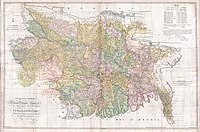Undivided Kamrup district

Undivided Kamrup district is a former administrative district located in Western Assam from which Kamrup Rural (2003), Kamrup Metropolitan (2003), Barpeta (1983), Nalbari (1985) and Baksa (2004) districts were formed.[1][2] It was announced in January 2020 that the Bajali sub-division of Barpeta district will be upgraded to a full district.
Establishment[edit]
Pre-Independence[edit]

The administrative district of Kamrup was first constituted from the western portion of the Ahom kingdom then under the Burmese Empire that the British acquired following the Treaty of Yandaboo of 1826.[3] The western boundary of this district was the Manas river,[4] and the eastern boundary of this district was the Barnadi river.[4] After 1826 the British administered the newly acquired regions via two commissioners: the Senior Commissioner who administered the "North-East of Rangpur" (largely the undivided Goalpara) in addition to the newly acquired region between Manas river and Biswanath; and the Junior Commissioner, who administered the region to the east of Biswanath.[5] In March 1833 the British established district administration in the region west of the Dhansiri river, with the Kamrup district originally envisaged as two separate districts among 3 others: the six parganas largely co-terminus with present-day Barpeta and Nagarberra; and the twenty parganas in the north and six duars in the south.[6] Each district were to be administered by a Principal Assistant, deputed by a Junior Assistant. But due to a paucity of funds, the six pargana region had only a Junior Assistant, and by 1836, the Kamrup district acquired its "undivided" form and name.[7]
Post-Independence[edit]
The district retained its colonial administrative structure post Independence of India in 1947. In 1983 Barpeta district was split from Kamrup.[8] Nalbari district was then similarly split off on 14 August 1985.[8] On 3 February 2003 Kamrup Metropolitan district was formed to cover the urban core of the district,[8] and 1 June 2004 saw the formation of Baksa district which was formed from parts of three districts—Barpeta, Nalbari and Kamrup districts.[8] The headquarters of both Kamrup Metropolitan and Kamrup districts is at Guwahati.[2]
History[edit]

Guwahati, the headquarters of Undivided Kamrup district, was the political center of two of the three Kamarupa dynasties. After the breakup of the Kamarupa kingdom, the region faced several invasions by the rulers of Bengal. Soon after the invasion of Malik Ikhtiyaruddin Iuzbak in 1257 CE, Sandhya, a Kamarupa ruler, moved his capital to North Bengal and established the Kamata kingdom; but its control of the region that later came to be Undivided Kamrup district was lax.[9] This region thus stopped being a political center till the capital of Assam was moved in the 20th century from Shillong to Dispur.
See also[edit]
Notes[edit]
- ^ "Five years of Kamrup district bifurcation". assamtribune.com. Retrieved 2013-01-24.
- ^ a b "Welcome to Kamrup Metro District". indianngos.com. Retrieved 2013-01-24.
- ^ Subodh Kapoor - 2002, The Indian Encyclopaedia: Biographical, Historical, Religious ..., Volume 1 In this war which was fought not only in Assam but also in Burma, the Burmese were ultimately defeated and had to make peace with the British by the treaty of Yandabo (1826) by which the Burmese withdrew from Assam.
- ^ a b (Hunter 1879, p. 17)
- ^ (Bannerjee 1992, pp. 7–8)
- ^ (Bannerjee 1992, p. 53)
- ^ (Bannerjee 1992, pp. 53–54)
- ^ a b c d Law, Gwillim (2011-09-25). "Districts of India". Statoids. Retrieved 2011-10-11.
- ^ (Kamarupa) was reorganized as a new state, 'Kamata' by name with Kamatapur as capital. The exact time when the change was made is uncertain. But possibly it had been made by Sandhya (c. 1250 – 1270) as a safeguard against mounting dangers from the east and the west. Its control on the eastern regions beyond the Manah (Manas river) was lax."(Sarkar 1992, pp. 40–41)
References[edit]
- Bannerje, A C (1992). "Chapter 1: The New Regime, 1826-31". In Barpujari, H K (ed.). The Comprehensive History of Assam: Modern Period. Vol. IV. Guwahati: Publication Board, Assam. pp. 1–43.
- Baruah, S. L. (1993). Last Days of Ahom Monarchy. Munshiram Manoharlal Publishers Pvt Ltd, New Delhi.
- Gogoi, Jahnavi (2002). Agrarian System of Medieval Assam. New Delhi: Concept Publishing Company.
- Hunter, William Wislon (1879). A Statistical Account of Assam. Vol. 1. Trübner & co. Retrieved 2012-12-13.
- Nath, D (1989). History of the Koch Kingdom: 1515-1615. Delhi: Mittal Publications.
- Richards, John F. (1995). The Mughal Empire. Cambridge: Cambridge University Press. ISBN 0521566037. Retrieved January 26, 2013.
